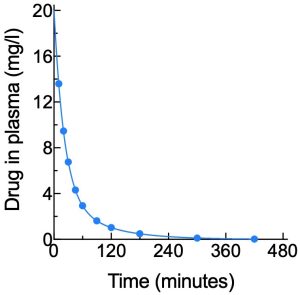Clearance
Clearance is defined as the volume of plasma cleared of drug in unit time. However, the “plasma” refers to the plasma volume that makes up the entire volume of distribution for the drug in question. So a clearance value of 30 litres/hour seems quite high, but if the volume of distribution is 1500 litres then it is still going to take a very long time to clear most of the drug from the body.
Clearance is related to AVD through the first order elimination rate constant (kel) for a one-compartment drug, or specifically to AVD area through the beta rate constant for a two-compartment drug. These rate constants indicate the proportion of the total volume that will be cleared in unit time (but not the proportion of remaining drug which will be cleared in unit time – see the entry for first order elimination rate constant). For example, if clearance is 15 litres/hour and AVD (or AVD area) is 150 litres then 10%, or 0.1, of the volume is cleared in unit time, so kel (or β) would be 0.1/hour, and half-life would then be 0.693/0.1 = 6.93 hours.
“Clearance” typically refers to total body clearance. It is the sum of individual organ clearances – usually hepatic clearance + renal clearance. Note that a change in hepatic function will have little or no impact on ClT for a drug that is cleared predominantly by the kidneys, and similarly a change in renal function will have little or no impact on ClT for a drug that is cleared predominantly by hepatic metabolism.

A value for clearance can be obtained from ClT = Dose/AUC0-∞, where AUC0-∞ refers to the area under a plasma concentration versus time curve from time zero to time infinity, when all drug has been eliminated. This calculation is independent of the number of compartments required to describe the drug’s disposition.

